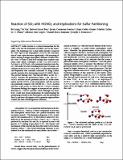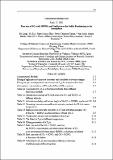Por favor, use este identificador para citar o enlazar a este item:
http://hdl.handle.net/10261/280339COMPARTIR / EXPORTAR:
 SHARE SHARE
 CORE
BASE CORE
BASE
|
|
| Visualizar otros formatos: MARC | Dublin Core | RDF | ORE | MODS | METS | DIDL | DATACITE | |

| Título: | Reaction of SO3with HONO2and Implications for Sulfur Partitioning in the Atmosphere |
Autor: | Long, Bo; Xia, Yu; Bao, Junwei Lucas; Carmona-García, J.; Gómez Martín, Juan Carlos CSIC ORCID; Plane, John M.C.; Saiz-Lopez, A. CSIC ORCID; Roca-Sanjuán, Daniel; Francisco, Joseph S. | Fecha de publicación: | 16-may-2022 | Editor: | American Chemical Society | Citación: | Journal of the American Chemical Society 144: 9172-9177 (2022) | Resumen: | Sulfur trioxide is a critical intermediate for the sulfur cycle and the formation of sulfuric acid in the atmosphere. The traditional view is that sulfur trioxide is removed by water vapor in the troposphere. However, the concentration of water vapor decreases significantly with increasing altitude, leading to longer atmospheric lifetimes of sulfur trioxide. Here, we utilize a dual-level strategy that combines transition state theory calculated at the W2X//DF-CCSD(T)-F12b/jun′-cc-pVDZ level, with variational transition state theory with small-curvature tunneling from direct dynamics calculations at the M08-HX/MG3S level. We also report the pressure-dependent rate constants calculated using the system-specific quantum Rice-Ramsperger-Kassel (SS-QRRK) theory. The present findings show that falloff effects in the SO+ HONOreaction are pronounced below 1 bar. The SO+ HONOreaction can be a potential removal reaction for SOin the stratosphere and for HONOin the troposphere, because the reaction can potentially compete well with the SO+ 2HO reaction between 25 and 35 km, as well as the OH + HONOreaction. The present findings also suggest an unexpected new product from the SO+ HONOreaction, which, although very short-lived, would have broad implications for understanding the partitioning of sulfur in the stratosphere and the potential for the SOreaction with organic acids to generate organosulfates without the need for heterogeneous chemistry. © 2022 American Chemical Society | Descripción: | 6 pags., 3 figs., 1 tab. | Versión del editor: | http://dx.doi.org/10.1021/jacs.2c03499 | URI: | http://hdl.handle.net/10261/280339 | DOI: | 10.1021/jacs.2c03499 | ISSN: | 0002-7863 | E-ISSN: | 1520-5126 | Identificadores: | doi: 10.1021/jacs.2c03499 |
| Aparece en las colecciones: | (IQF) Artículos (IAA) Artículos |
Ficheros en este ítem:
| Fichero | Descripción | Tamaño | Formato | |
|---|---|---|---|---|
| Reaction of SO3.pdf | 562,73 kB | Adobe PDF |  Visualizar/Abrir | |
| Supporting Information.pdf | 363,49 kB | Adobe PDF |  Visualizar/Abrir |
CORE Recommender
SCOPUSTM
Citations
9
checked on 26-abr-2024
WEB OF SCIENCETM
Citations
7
checked on 28-feb-2024
Page view(s)
102
checked on 01-may-2024
Download(s)
64
checked on 01-may-2024
Google ScholarTM
Check
Altmetric
Altmetric
NOTA: Los ítems de Digital.CSIC están protegidos por copyright, con todos los derechos reservados, a menos que se indique lo contrario.
